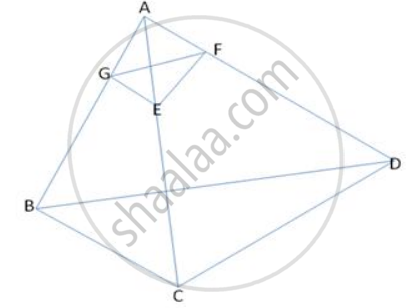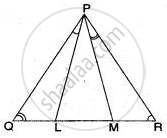Advertisements
Advertisements
प्रश्न
In the figure , ABCD is a quadrilateral . F is a point on AD such that AF = 2.1 cm and FD = 4.9 cm . E and G are points on AC and AB respectively such that EF || CD and GE || BC . Find `("Ar" triangle "BCD")/("Ar" triangle "GEF")`

उत्तर
In Δ ABC, GE || BC
∴ By BPT
`"AG"/"GB" = "AF"/"FD"` .......(1)
Similarly, in Δ ACD
`"AE"/"EC" = "AF"/"FD"` .....(2)
From ( 1) and (2)
`"AG"/"GB" = "AF"/"FD"`
∴ GE || BC ...(By converse of BPT)
In Δ AGF and Δ ABD
∠ A = ∠ A (common)
∠ AFG = ∠ ADB (Corresponding angles)
∴ Δ AGF ∼ Δ ABD (AA corollary)
∴ `"AF"/"AD" = "GF"/"BD"` (Similar sides of similar triangles)
`2.1/7 = "GF"/"BD"`
`3/10 = "GF"/"BD"`
`("Ar" triangle "GEF")/("Ar" triangle "BCD") = "GF"^2/"BD"^2`
[The ration of areas of two similar triangle is equal to the ratio of square of their corresponding sides.]
= `(3/10)^2`
= `9/100`
= 9 : 100
`("Ar" triangle "BCD") : ("Ar" triangle "GEF")` = 100 : 9
APPEARS IN
संबंधित प्रश्न
E and F are points on the sides PQ and PR, respectively, of a ΔPQR. For the following case, state whether EF || QR.
PE = 3.9 cm, EQ = 3 cm, PF = 3.6 cm and FR = 2.4 cm
The areas of two similar triangles ABC and PQR are in the ratio 9:16. If BC = 4.5cm, find the length of QR.
In the given figure, X is any point in the interior of triangle. Point X is joined to vertices of triangle. Seg PQ || seg DE, seg QR || seg EF. Fill in the blanks to prove that, seg PR || seg DF.

Proof : In ΔXDE, PQ || DE ...`square`
∴ `"XP"/square = square/"QE"` ...(I) (Basic proportionality theorem)
In ΔXEF, QR || EF ...`square`
∴ `square/square = square/square ..."(II)" square`
∴ `square/square = square/square` ...from (I) and (II)
∴ seg PR || seg DF ...(converse of basic proportionality theorem)
Construct a ΔABC in which CA = 6 cm, AB = 5 cm and ∠BAC = 45°. Then construct a triangle whose sides are `3/5` of the corresponding sides of ΔABC.
Points A(3, 1), B(5, 1), C(a, b) and D(4, 3) are vertices of a parallelogram ABCD. Find the values of a and b.
Find the area of the triangle ABC with the coordinates of A as (1, −4) and the coordinates of the mid-points of sides AB and AC respectively are (2, −1) and (0, −1).
In ΔPQR, L and M are two points on the base QR, such that ∠LPQ = ∠QRP and ∠RPM = ∠RQP.
Prove that : (i) ΔPQL ∼ ΔRPM
(ii) QL. Rm = PL. PM
(iii) PQ2 = QR. QL.
The areas of two similar triangles are 169cm2 and 121cm2 respectively. If one side of the larger triangle is 26cm, find the length of the corresponding side of the smaller triangle.
If ∆ABC is an isosceles triangle with ∠C = 90° and AC = 5 cm, then AB is
ΔABC and ΔBDE are two equilateral triangles such that D is the mid point of BC. Ratio of the areas of triangle ΔABC and ΔBDE is ______.
